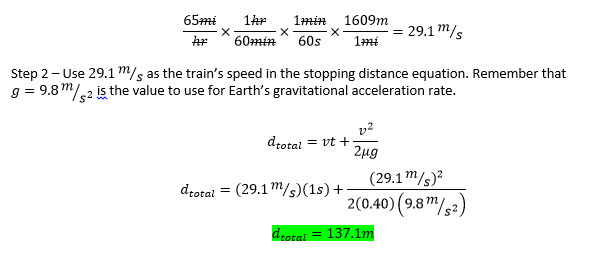Examples of Using the Stopping Distance Equation
Let's take a look at how to apply the stopping distance equation introduced on the previous page.
Example 1
You are the engineer of a freight train rolling along at ![]() , when you get a call on the radio that there's a herd of cows ahead on the track, about a quarter-mile (1/4 mile) away. Your perception-reaction time is 1 second, and the track conditions allow for a friction coefficient of
, when you get a call on the radio that there's a herd of cows ahead on the track, about a quarter-mile (1/4 mile) away. Your perception-reaction time is 1 second, and the track conditions allow for a friction coefficient of ![]() . Will you be able to get your train stopped in time?
. Will you be able to get your train stopped in time?
Step 1 - convert mph (miles per hour, the English velocity unit) to m/s (meters per second, the SI velocity unit). Note: you wouldn't always have to do this, since you might be given meters per second in the first place - but for now it's good practice.

Step 3 - convert meters back to miles for interpretation.

We find that 1/4 mile IS a sufficient stopping distance (the cows are safe) as long as your perception-reaction time is within 1 second, and you brake the train with maximum possible friction under good track conditions. Otherwise, the cows could be in greater danger.
